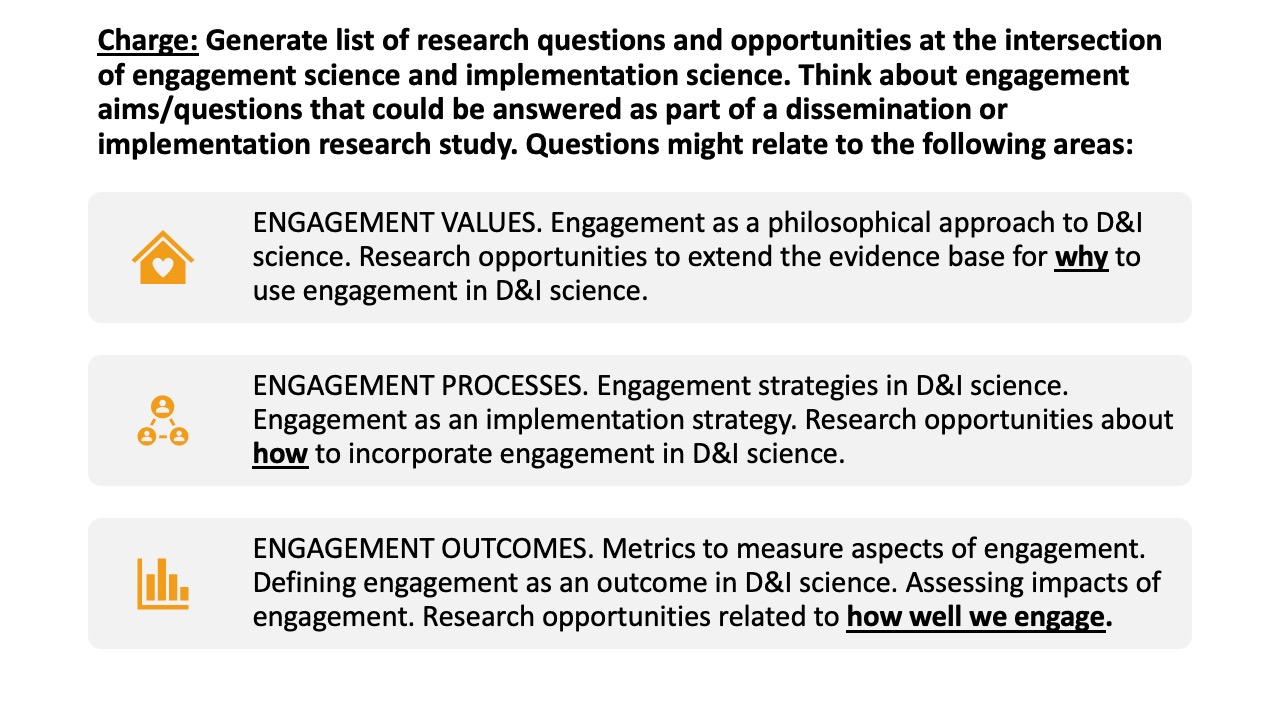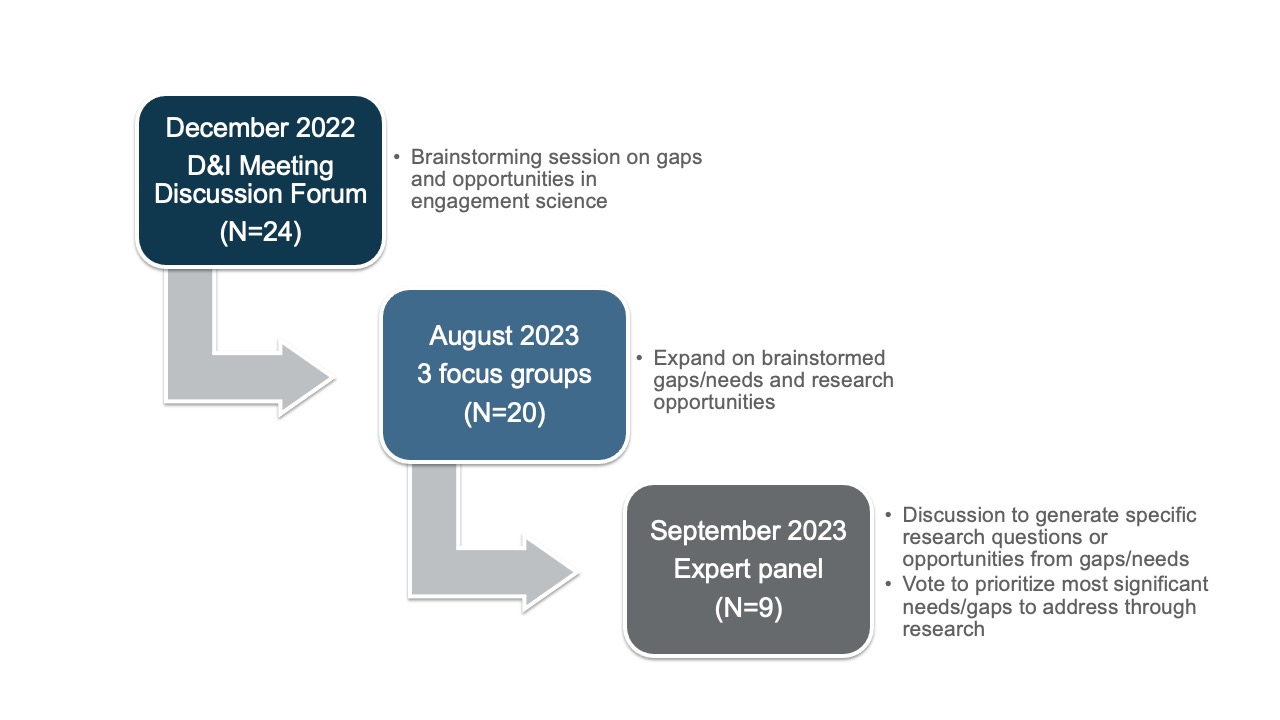Last year was my first time attending the Annual Conference on the Science of Dissemination and Implementation (D&I) in Health, which the National Institutes of Health (NIH) and Academy Health co-sponsor. Although the Washington Convention Center space initially felt cavernous and the agenda overwhelming, the attendees and exhibitors were warm and welcoming. Almost a year later, I am excited to share two initiatives I’ve been working on that came out of discussions held as part of the conference.
Despite being a new attendee, I was delighted to have the opportunity to lead a discussion forum titled “Research Opportunities at the Nexus of Engagement Science and Implementation Science.” We convened a brief panel of implementation and engagement science experts to set the stage for small group discussions. Along with several colleagues from across NIH and the Consortium for Cancer Implementation Science, we facilitated a brainstorming activity to identify important and opportunistic engagement-related scientific areas that might be explored through D&I research. Twenty-four attendees participated in a discussion focused on engagement values, processes, and outcomes (Figure 1).

In that initial discussion forum, participants described challenges in selecting (and as relevant, adapting) the right engagement approach; creating balanced, engaged research teams that acknowledge and leverage different expertise; funding and sustaining engagement efforts; and adapting/improving implementation strategies based on engagement. Participants also emphasized the importance of supporting trust and empowerment; creating meaningful engagement; addressing team power dynamics and leveling power differentials; and establishing appropriate payment/incentives for efforts expended by partners. Finally, forum participants referenced identifying and measuring engagement outcomes important to community partners; measuring the extent and quality of engagement, such as strengths and types of relationships, broad community dissemination, and sustained relationships; and assessing concordance between typical research outcomes and engagement outcomes.
Since the conference, I have been collaborating with Drs. Holly Peay, Sara Jacobs, and Elizabeth Reynolds from RTI International on a second phase of this initiative to expand on the brainstorming and prioritize the research opportunities identified, depicted in the figure below. Next month at the 16th Annual Conference on the Science of Dissemination and Implementation in Health, we will share our findings during the Monday poster session, Building the Future of D&I Science: Capacity Building, Infrastructure, and Emerging Research Areas, at 4:15 p.m. (poster #B-124).

The second exciting initiative I am co-leading that emerged from the 2022 D&I Conference was a new administrative supplement concept to support health policy research in cancer prevention and control (NOT-CA-23-044). The Division of Cancer Control and Population Sciences recently funded nine grantees, four of whom are working on community-engaged D&I relevant policy projects under “Option 2” of the funding opportunity:
- Alyce Adams (supplement lead) at Stanford Cancer Institute (parent award PI: Steven Artandi) – “Engaging communities in the design of equitable community benefit policies”
- Kimlin Ashing and Narissa Nonzee (supplement leads) at City of Hope Comprehensive Cancer Center (parent award PI: John Carpten) – “A multi-stakeholder health policy study using implementation science to advance access to cancer care and clinical trials for medically vulnerable populations”
- Tuya Pal (PI) at Vanderbilt University Medical Center and Deborah Cragun (parent award MPI) – “Expanding genetic risk assessment to underserved populations: a cancer registry-based approach”
- Noel Brewer (PI) and Nadja Vielot (supplement lead) at University of North Carolina at Chapel Hill – “Characterizing clinical decision support for HPV vaccination in immunization information systems”
Between the engagement science research opportunities project and new health policy administrative supplements, I certainly got a lot out of the meeting last year and hope this work will help advance the field. I am very much looking forward to attending this year’s conference, “Raising Expectations for D&I Science: Challenges and Opportunities.” I served as an abstract reviewer and am excited to be leading an oral presentation and poster, as well as chairing a panel session. Learn more, check out the agenda, and register online now. If you have any thoughts about how we can continue to foster advances in engagement science and cancer implementation science, please feel free to get in touch (aubrey.villalobos@nih.gov).
Aubrey Van Kirk Villalobos, DrPH, MEd, is a Health Scientist with the Implementation Science (IS) Team in the Office of the Director in the Division of Cancer Control and Population Sciences (DCCPS) at the National Cancer Institute (NCI).

Dispatches from the Implementation Science Team, is an episodic collection of short form updates, authored by members and friends of the IS team representing a sample of the work being done and topics that our staff are considering for future projects. Topics address some of the advances in implementation science, ongoing issues that affect the conduct of research studies, reflections on fellowships and meetings, as well as new directions for activity from our research and practice communities.


